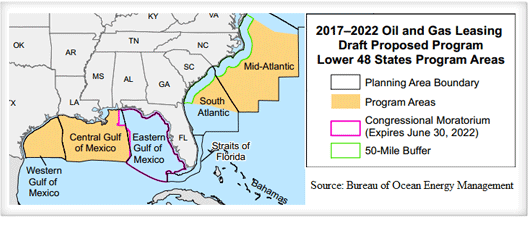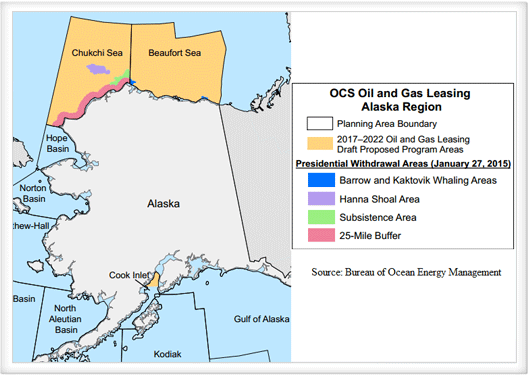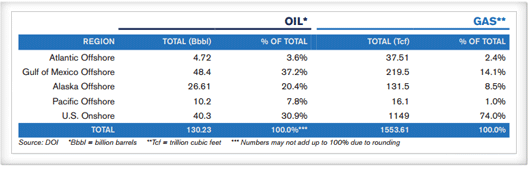President Obama Opens up Atlantic Coast for Oil and Gas Drilling, Restricts Alaskan Waters
On January 27th, President Obama and Secretary of the Interior Sally Jewel announced that the Administration would take steps to open up portions of the United States Atlantic coastline for offshore drilling as part of the Department of the Interior’s Five-Year Outer Continental Shelf (OCS) Oil and Gas Leasing Program for 2017-2022. The department’s Draft Proposed Program would create fourteen potential lease sales in eight coastal planning areas around the nation, including the first offshore lease offering for drilling off the southeast coast of the US in Virginia, the Carolinas, and Georgia.

The Administration also announced three lease offerings off the Alaskan coastline in the Chukchi Sea, the Beaufort Sea, and Cook Inlet. Importantly, however, the Administration announced that it would designate certain “Withdrawal Areas” as off-limits from future oil and gas leasing due to the “substantial environmental, social, and ecological concerns in the Arctic.”

The announcement was met quickly with both praise and criticism from energy and environment stakeholders. Conservation-minded groups, while highly supportive of the Administration’s decision to protect Alaska’s Arctic National Wildlife Refuge (ANWR), were angered by the news of potential drilling in the south Atlantic, citing ongoing risks for spills like the BP Deepwater Horizon incident in 2010. Sierra B. Weaver, a Southern Environmental Law Center attorney, told ThinkProgress, “In 2010 after the BP Deepwater Horizon disaster in the Gulf, the Obama administration cancelled a lease sale off of Virginia because it was also too risky. That risk hasn’t changed.”1 To Peter Lehner, the National Resource Defense Council’s executive director, the decision “would put our oceans, beaches, wetlands, and all they support at grave and needless risk, imperil coastal communities and economies, and anchor our future to the dirty fossil fuels of the past.”
Reactions to the announcement were mixed in Congress, where the news unsurprisingly drew the biggest responses from law-makers with affected home-state coastlines. Alaska Senator Lisa Murkowski (R), now Chair of the Senate Energy and Natural Resources Committee, described the Administration’s Alaska restrictions as “a kick to the gut of Alaska’s economy.” Alongside fellow Alaskans Senator Dan Sullivan (R) and Representative Don Young (R), she pledged to “do everything we can to push back against [the] administration” and the decision to restrict certain areas from oil and gas development. Alaska’s state government relies enormously on oil and gas revenues to fund state programs and services, with as much as 92% of the state’s unrestricted revenue coming from oil and gas activity in recent years.
On the eastern coastline of the country, the administration’s plan includes what could become the first lease in history for offshore oil and gas drilling in the Mid- and South Atlantic planning areas. According to the DOI’s Bureau of Ocean Energy Management (BOEM), these two planning areas contain 7.52 billion Barrel of Oil Equivalents (BOEs) of energy from technically recoverable oil and gas reserves. Despite the opening of this previously untapped market, however, the recent precipitous drop in oil prices may only garner minimal interest in any Atlantic lease offerings made.

Despite these and other questions about levels of interest in and the value of Atlantic drilling leases, Virginia Senators Tim Kaine (D) and Mark Warner (D) released a joint statement calling the Atlantic announcement a “significant step…that should result in the safe, responsible development of energy resources off the Virginia and mid-Atlantic coasts.” They did note, however, that they would advocate for legislation to allow Virginia and other coastal states in the southeast to obtain the same revenue-sharing benefits reaped by Gulf Coast states. Members of the Outer Continental Shelf Governors Coalition (OCSGC), including Governors Terry McAuliffe (D-VA), Pat McCrory (R-NC) and Nikki Haley (R-SC), had previously lobbied the Obama Administration for expanded drilling access, and they also praised this South Atlantic announcement as “a step in the right direction.” The group did bemoan, however, what they saw as an “unnecessary” 50-mile buffer zone.
Law-makers from neighboring states were not so positive about the Atlantic announcement: New Jersey Senator Bob Menendez (D) said “all of the risk is put on the backs of our shore communities, and all the reward goes to Big Oil.” Menendez, who was joined by Senators Ben Cardin (D-MD), Cory Booker (D-NJ), and Ed Markey (D-MA) in his opposition, went on to say that an oil spill in the Atlantic would be catastrophic for his state, which relies heavily on a $38 billion per year tourism industry.Foreshadowing an ongoing fight between Senate Democrats and the Obama Administration, Senator Markey characterized the group’s efforts as “the beginning of an alliance to put pressure on this administration to withdraw this proposal.” The administration’s proposal is still in draft form and may be altered after a public commentary period, but the final plan will not require congressional approval and authorization.
The Administration’s announcements represent an early but major step in the development of the federal Outer Continental Shelf (OCS) Oil and Gas Leasing Program for 2017-2022, a process that will take several years to finalize. Secretary Jewell characterized the initial plan as “a balanced proposal that would make available nearly 80 percent of the undiscovered technically recoverable resources, while protecting areas that are simply too special to develop." Secretary Jewell, along with BOEM Director Abigail Ross Hopper, stated that federal officials were “looking to build up our understanding of resource potential, as well as risks to the environment and other uses.”
As supporters and detractors begin to make their cases for and against the administration’s Atlantic and Alaskan drilling proposals, early indications point to a rocky road to implementation for the 2017-2022 Oil and Gas Leasing Program.
![]()
If you have any questions about this topic, please contact the author(s) or your principal
Mintz Levin attorney.
![]()
![]()
Endnotes
1 http://thinkprogress.org/climate/2015/01/27/3615965/oil-and-gas-drilling-proposal-atlantic/
3 http://www.aoga.org/facts-and-figures/state-revenue
4 U.S. Department of the Interior, Bureau of Ocean Energy Management. (2014). Assessment of Undiscovered Technically Recoverable Oil and Gas Resources of the Atlantic Outer Continental Shelf, 2014 Update, pp. 2
5 http://ocsgovernors.org/governor-mccrory-applauds-step-toward-offshore-energy-exploration/
Author

